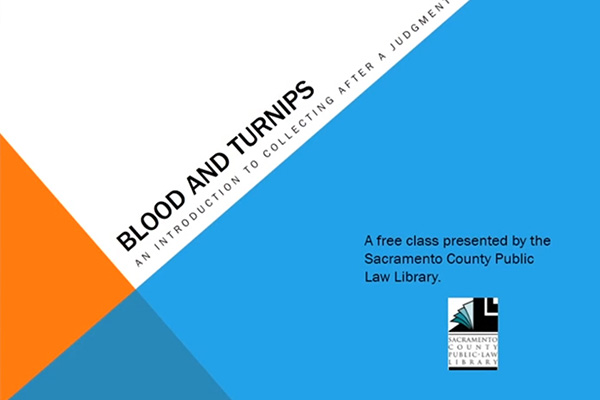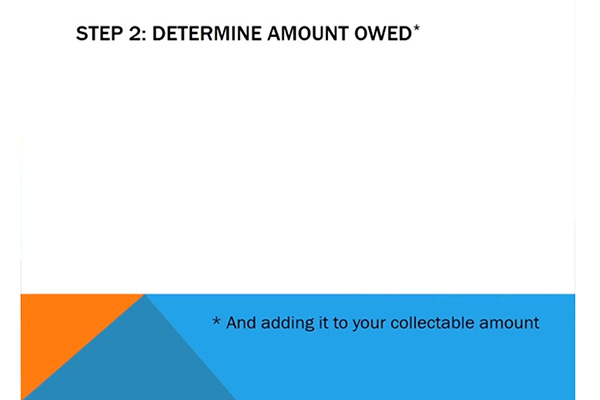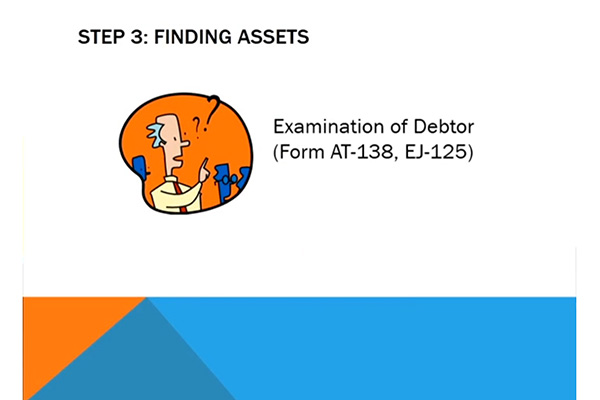Enforcing a Court’s Judgment Category: Courts and Procedure
Overview
After obtaining a judgment, the plaintiff is known as a “judgment creditor” and the defendant is the “judgment debtor.” The creditor must take steps to collect their judgment, the court does not do anything automatically. However, the creditor may request a variety or orders and other documents used to collect money or other property from the debtor. These include wage garnishments (automatic deduction of up to 25% of the debtor’s paycheck), bank levies (seizing money out of the debtor’s accounts), placing a lien on the creditor’s real estate, and more.
The debtor can resist these methods by filing a claim of exemption for assets which are exempt from collection, such as a specified amount of wages depending on family size, Social Security and other benefits, most personal property, and automobiles up to a certain value.
Videos for Self-Helpers
SH@LL and the Law Library have produced a series of videos for people representing themselves in California civil cases.
This series of videos will help you understand the different methods of enforcing a civil judgment and how to use them. Watch our video playlist on YouTube:
Enforcement of Judgments
After obtaining a judgment, the judgment creditor’s next step is to attempt to collect what is owed. The court does not collect judgments; the prevailing party is responsible for all collection efforts. However, the court may issue a variety of orders and other documents that may be used to collect...
Read MoreExemption from the Enforcement of Judgments
This list includes the most common assets and income that may be exempt from levy upon a judgment. This means that state and federal laws prohibit judgment creditors from taking these types of property in order to satisfy their judgment. Exemptions are found in the United States Code (USC) and...
Read MoreSH@LL (Self Help @ the Law Library) (formerly Civil Self Help Center)
Accidents and Torts

SH@LL provides general information and basic assistance to people without attorneys on a variety of civil legal issues. All assistance is provided by telephone or Zoom videoconference. Visit “What We Help With” for a list of qualifying cases.
Eligibility: Must be a Sacramento County resident or have a qualifying case in the Sacramento County Superior Court.
Abstract of Judgment: Putting a Lien on Real Estate after a Judgment
Preparing an Abstract of Judgment, Civil and Small Claims (EJ-001) is the first step a judgment creditor must take in order to place a lien on a judgment debtor’s real property or a judgment debtor’s potential recovery in a pending lawsuit. Templates and Forms Abstract of Judgment, Civil and Small...
Read MoreBank Levy
After you’ve won your lawsuit and received a judgment against the other party, your next step is to attempt to collect what you’re owed. The court does not collect your judgment for you– as the judgment creditor, this is your job. If the judgment debtor has a bank account, you...
Read MoreClaim of Exemption – Bank Levy
If you receive notice from your bank that funds have been withdrawn due to a court judgment (“levied”), and you want to object, act fast. You have 15 days (20 days, if you were served by mail) to file a Claim of Exemption. Here’s how. Templates and Forms Claim of...
Read MoreDebtor’s Examination
A debtor’s examination, also known as an order of examination, is often a preliminary step before initiating collection efforts. This examination is a formal court proceeding in which the judgment creditor may question the debtor to obtain information about the location and value of the judgment debtor’s assets, including paychecks...
Read MoreMemorandum of Costs after Judgment
When you win a lawsuit, you can collect the total amount of the judgment entered by the court, plus any costs incurred after judgment and accrued interest on the total amount. To have costs and interest added to the amount owed, you must file and serve a Memorandum of Costs...
Read MoreRenewal of Judgment
Money judgments automatically expire after 10 years. Once a judgment expires, it is no longer enforceable, and the judgment creditor is not able to collect any unpaid judgment amounts. To prevent this from happening, the judgment creditor must renew the judgment before the 10 years run out. Templates and Forms...
Read MoreSatisfaction of Judgment
Once a judgment is paid, either in full or in an amount the judgment creditor agrees to accept as full payment, the judgment creditor must immediately file an Acknowledgement of Satisfaction of Judgment (EJ-100) with the court (California Code of Civil Procedure (CCP) § 724.030). This form serves as a...
Read MoreWage Garnishment
After you win your lawsuit and receive a judgment against the other party, your next step is to attempt to collect what you are owed. The court does not collect your judgment for you; you must do it yourself. If the judgment debtor has a job, you may be able...
Read MoreClaim of Exemption: Wage Garnishment
If you receive notice from your employer that your wages are being garnished, and you want to object, act fast. The sheriff will hold your wages for 10 days before delivering them to the creditor. You can file a claim of exemption at any time, but until you do, the...
Read MoreMotion to Pay Judgment in Installments: Requesting Installment Payments
California Code of Civil Procedure (CCP) § 582.5 allows a judgment debtor in a limited civil case (amount demanded is under $25,000, or under $35,000 if filed after Jan. 1, 2024) to ask the court for an order allowing the judgment to be paid in installments. This request is made...
Read MoreNotice of Automatic Stay
Filing for bankruptcy immediately stops all attempts to collect debts included in the bankruptcy from you, including lawsuits. This is known as the “automatic stay.” Perhaps you have been sued, and are planning to file for bankruptcy. Or maybe you are already in bankruptcy, and you have received a summons...
Read MoreRequest a Default Judgment by Court
A defendant has 30 days from the date he or she is personally served with your summons and complaint to file a written response, or 40 if you served them by substituted service. (California Code of Civil Procedure (CCP) § 412.20(a) (3)). This is not an automatic cutoff. The court...
Read MoreRequest a Default Judgment by Clerk
WARNING Unless the case is a clear-cut breach of contract case with a written amount due, you will probably need a Default Judgment by Court. Visit Default Judgment by Court for the correct guide. Flow chart to select between judgment by clerk and judgment by court A defendant has 30...
Read More



 Back to Search
Back to Search 

